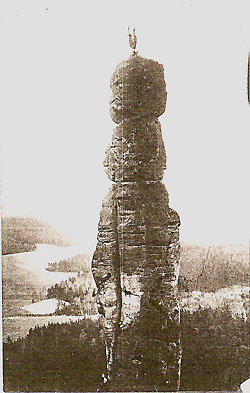 Oliver Perry-Smith doing a headstand on Barbarine ca 1905 |
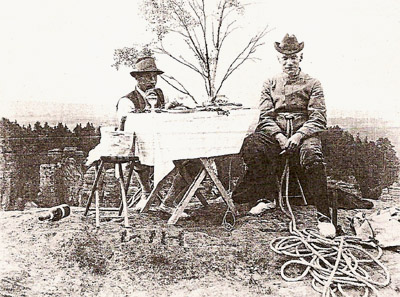 Perry-Smith dining with Count ??? on an Elbsandstein Summit ca 1907 |
Historical Rock Climbing
Images
|
Oliver Perry-Smith - Continued |
 Oliver Perry-Smith doing a headstand on Barbarine ca 1905 |
 Perry-Smith dining with Count ??? on an Elbsandstein Summit ca 1907 |
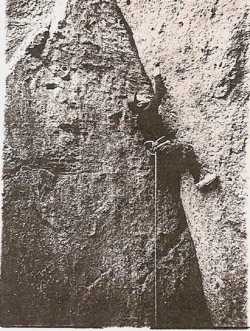 Oliver Perry-Smith leading a crack climb Prior to 1913 |
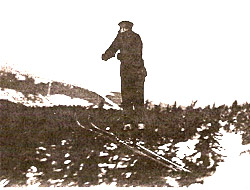 Ski-jumping |
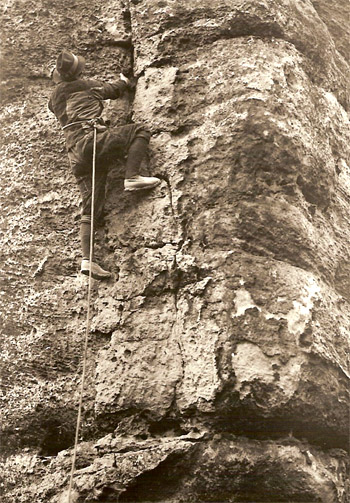 Perry-Smith? . . . Possibly Photo Walter Hahn |
Oliver Perry-Smith climbed from 1902 through 1913 - between the ages of 18 and 29. The year Preuss died, Perry-Smith's record of climbs ends. Preuss was only two years younger than the American, and perhaps the two were acquainted. In addition, there may have been a tenuous link between Perry-Smith, Preuss, and Oscar Eckenstein: Eckenstein designed and created very short ice axes, as well as crampons, and spent much time in the Alps between 1900 and 1914. He taught Preuss ice-climbing skills over two seasons in the western Alps. Perry-Smith at least mentions Preuss's routes in the Alps in correspondance; also, the young American is said to have used an unusually short ice-axe on one or more occasions. Perry-Smith visited the Alps frequently, making a notable traverse of the Matterhorn and actually laying plans to climb its north face. He finished his mountaineering in the High Alps in 1910, but continued to climb in Saxony until 1913. A Powerful Skier . . . "For several years he had been equally interested in skiing, and soon gained international recognition in this sport as well. As the first foreigner to compete successfully against the hitherto unapproachable Norwegians, his phenomenal strength made him particularly formidable in cross-country runs. His keenness made him a jumper." (Thorington). C. J. Luther, a close friend and the ski-historian of Partenkirchen, says of Oliver: "He directed a fresh wind from the outside world to the still dreamy eastern mountains, which put the younger generation on its feet. With an almost primitive drive in sporting accomplishment he was an inspiring companion. His was the tall, muscular stature of the American pioneer; one knew he could not be defeated." Although he had raised many a stein with his comrades over the years, by 1914 he "drank nothing stronger than lemonade, even at Christmas and New Year celebrations, when among the winter sport guests champagne flowed in streams." In 1911, after placing second in a German skiing event, a critic wrote of him: "An American in whose blood the record-demon courses. He is as unruly as a stallion, and a go-getter. He is not a companionable sportsman . . ." Companionable or not, he captured the cross-country championship of Austria at Kitzbühel in 1914. In September of that year, he and his young wife, Agnes, and three year old son, Ollie, left Germany for America, and never returned. |
| As Thorington puts it: "Here we may leave Oliver Perry-Smith, remembering him as the most agile American climber of his time, the first man to consistently climb 6th degree walls and the first American skier to succeed in international competition . . . " |
|
The Rest of His Life . . .
He served with
distinction in the 10th Mountain
Division in
Oliver in Colorado . . . In the mid 1960s Crosby was an instructor at the Mountain & Cold Weather Command at Ft. Carson. One weekend his troops went climbing on the Flatirons above Boulder, Colorado. There they saw an old man soloing without a rope. It turned out to be Oliver Perry-Smith. When Crosby told his father he didn't think he should be out climbing without a rope on the Flatirons at his age, Oliver said to him, with a grin, "There's only one place I might need a rope." From Thorington: "In his 80th year he still cherishes the dream of reascending the Guglia di Brenta!" Oliver Perry Smith died at the age of 84 in 1969. Photo of Crosby Perry-Smith by Janet Carlile |
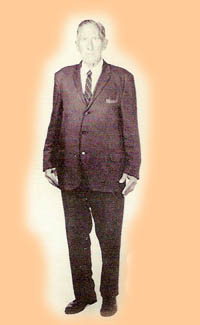 Oliver Perry Smith at age 79 Photo courtesy AAC Library |